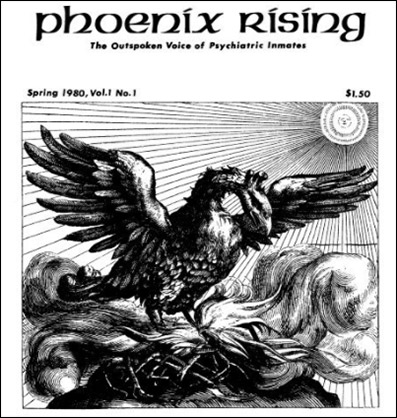Phoenix Rising
By Irit Shimrat
Phoenix Rising: The Voice of the Psychiatrized was a Canadian antipsychiatry magazine published in Toronto from 1980 to 1990. I was extremely fortunate to edit Phoenix during its final four years. It’s the best thing I’ve ever worked on. I am so grateful to the magazine’s co-founder (and the grandpappy of Canadian antipsychiatry), my dear friend, Don Weitz, for hiring me in 1986 and for all our decades of collaboration. I am also deeply grateful to Jim Gottstein – mental health lawyer extraordinaire, and author of the amazing book The Zyprexa Papers (see www.psychrights.org) – for putting the Phoenix archives up online.
Don recalls:
“Phoenix Rising – Canada’s only antipsychiatry magazine to date – was produced out of an apartment starting in 1980. My close friend, electroshock survivor Carla McKague, was a student lawyer at the Queen Street Mental Health Centre, and she and I decided to start the magazine. It was Carla who suggested the title, based on the Greek myth of the phoenix rising from the ashes. We were always antipsychiatry, and everyone who worked on Phoenix was a psychiatric survivor. We never changed our focus on drugs, shock, and the psychiatric system – because, as I said at one meeting, ‘We know that the system is not helpful or beneficial, and we’re going to write about it and expose it.’ And that’s what we kept doing, until our final issue – the special gay and lesbian double issue published in July 1990. I’m very proud of that issue and of each one of our 29 others.
“It was in the fall of 1980 that we broke the story of the drugging death of Aldo Alviani, largely thanks to Bonnie Burstow, a faculty member at the University of Toronto’s Ontario Institute for Studies in Education, who was a major contributor to Phoenix. Alviani was only 19 years old when he died at the Queen Street Mental Health Centre. He was drugged to death with the “antipsychotic” Haldol, one of the most vicious, most powerful drugs in psychiatry. He was trying to resist, after being brought in by the police for some kind of misdemeanor. For the next 72 hours, they drugged the shit out of him, against his will. We were the only magazine in Canada that investigated and exposed psychiatric survivor deaths, the drugging, and the use of electroshock, especially on women.
“I will always be grateful to Carla, who not only wrote our legal column but also did much of the editing. We had five people on the first editorial collective: Mike Yale and Joanne Yale, who were both blind and were big contributors; Cathy McPherson, who was our first real editor; and Carla and myself. We solicited articles from other survivors – and not only articles, but also poetry, personal stories, diary excerpts, whatever people wanted published. We would collect material, and then lay out the magazine.
We had no computer, only one electric typewriter.
“I also gratefully remember all the hard and dedicated work of Maggie Tallman, who used to have a column called ‘Maggie’s Bag,’ featuring personal stories, parts of interviews, and miscellaneous snippets. Maggie was such a huge help, serving as our bookkeeper and business manager and helping us keep the magazine going for several years.
“We put out four double issues: one on shock and one on the Canadian Charter of Rights and Freedoms, where we talked about the Charter as it related to psychiatric survivors’ rights. We also published a total of three special issues on women. We were the only ones exposing the sexism in the psychiatric system: how women were singled out and discriminated against. And we had two special issues on the Canadian prison system and psychiatry. Eventually I wrote a piece for Borderlines Magazine, which helped Phoenix become better known (‘Remembering Phoenix Rising,’ Borderlines, Fall 1990). And the famous journalist, author and social activist June Callwood (known as ‘Canada’s Conscience’) gave us a big boost by writing a piece about Phoenix in the mid-1980s. I respected June very much, and still miss her.
“We made sure our cover and subscription price was really cheap because we didn’t want to make money off of our brothers and sisters. We also sent out many free copies. It was editorial policy to send a free subscription to any prisoner or psychiatric inmate in Canada. It wasn’t always easy getting copies of the magazine to psychiatric inmates. We sent a copy to one of our subscribers who was an activist, and was locked up at the time at Queen Street; the staff tried to confiscate it and throw it in the garbage. We sent copies by regular mail. We knew the mail wasn’t censored, but maybe sometimes it was intercepted and thrown away. Fortunately, most of the time, inmates received the magazine.
“During our ten years of struggling to keep Phoenix afloat, we got some money from the Ontario Women’s Directorate for our special women’s issues. We also received grants from Health and Welfare and other government ministries, including money for two special issues on housing that I’m especially proud of. We were one of the first magazines to expose and denounce homelessness and its horrific impact on psychiatric survivors, and its major role in causing people to get psychiatrized in the first place. We wanted to counteract the mainstream media garbage, still prevalent, about ‘mental illness’ being a ‘cause’ of homelessness.
“We never applied for, and never would have accepted, ‘mental health’ funding.
“To find new contributors, we publicized Phoenix among psych survivors by word of mouth, through phone calls, and at drop-ins, advocacy groups and community centres, saying we needed people with writing or research skills. Many people contributed to the magazine and, for most, it was their first opportunity to get published. I’m very proud of what Phoenix accomplished.”


